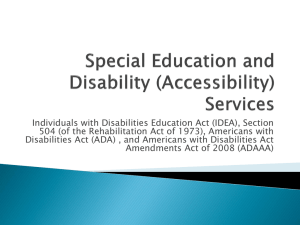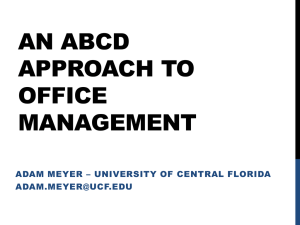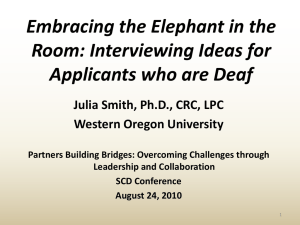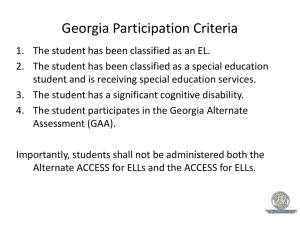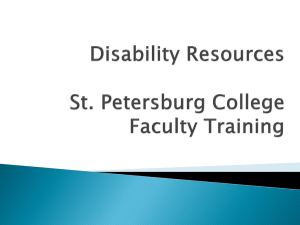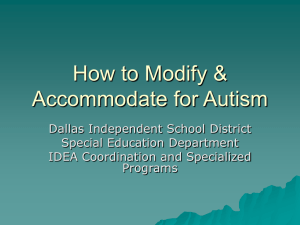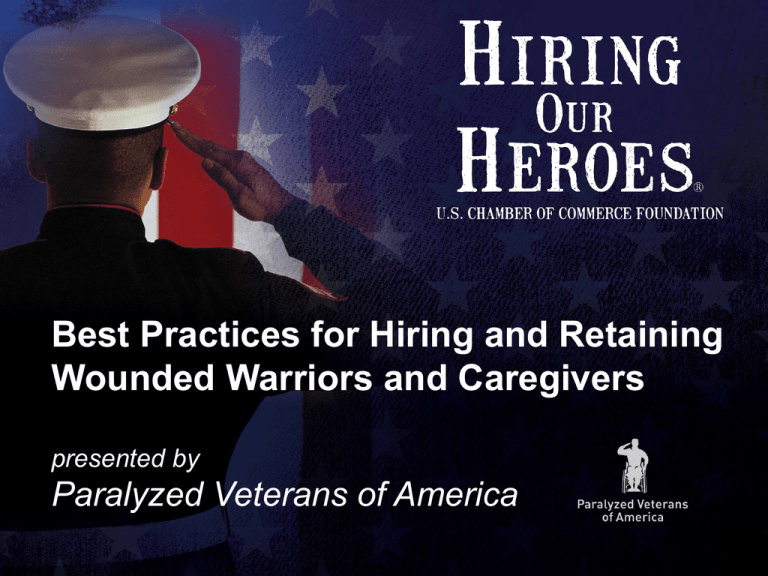
Best Practices for Hiring and Retaining
Wounded Warriors and Caregivers
presented by
Paralyzed Veterans of America
Disability Employment Experts
Susan Prokop
Associate Advocacy Director
Paralyzed Veterans of America
David Galbo
Associate Director of Architecture
Paralyzed Veterans of America
Shelly Edwards
Associate Director Operation PAVE
Paralyzed Veterans of America
2
Disability Awareness
Veterans & Disability: The Numbers
56 Million Disabled Americans
3.2 Million Disabled US Veterans
Disability Awareness
Unemployment & Labor Force Participation Rates for
Gulf War era II Veterans
Source: Department of Labor, Bureau of Labor Statistics, Employment Situation of Veterans Summary. Released March 20, 2014.
http://www.bls.gov/news.release/vet.nr0.htm
Disability Awareness
Caregivers – Unique Issues and Challenges
9% of U.S. adults are caregivers
16.9 M civilian caregivers
4.4 M pre-9/11 military caregivers
1.1 M post-9/11 military caregivers
Caregivers are often “invisible” in the workplace
Caregivers must strategize around the critical and
unpredictable needs of their loved ones
Source: National survey of caregivers of adults in the U.S. with findings presented in Ramchand R, Tanielian T. et al.,
Hidden Heroes: America’s Military Caregivers. RAND Corporation, 2013 (available at www.rand.org/military-caregivers)
Win-Win Scenarios
Disability Compliance Is The Law - But Also An Asset
Military veterans and military caregivers come from a
culture that intensely values loyalty… turn that quality
in an asset for your firm-and increase workforce
retention
Accessibility, accommodation and flexibility are
desirable employer traits for ALL prospective
employees – not just those with disabilities
Demonstrating your corporate commitment to making
a difference in the lives of veterans with disabilities and
their caregivers is good for business
Americans with Disabilities Act
The Basics
The ADA has 5 different Sections called “Titles”
ADA In General
Title I : Employment
Title II : State and Local Government Services and Public Transportation
Title III : Public Accommodations and Commercial Facilities
Title IV : Telecommunications
Title V : Retaliation, Technical Assistance, and Miscellaneous Provisions
We are focused on Title I: Employment
Title I of the Americans with Disabilities Act (ADA) of 1990 prohibits
covered entities from discriminating against covered individuals in
all covered employment practices
7
7
Requirements & Incentives
Special Hiring Authorities and Tax Benefits
For Federal Contractors
Section 503- recruitment &hiring people with disabilities
VEVRAA- Recruitment & Hiring Veterans [including veterans with
disabilities]
OFCCP Resources
For Federal Agencies
Section 501 Recruiting & Hiring Obligations
Schedule A Hiring Authority
Business Deductions
Disabled Access Credit
Architectural Barrier Removal Tax Deduction
Work Opportunity Tax Credit
Reasonable Accommodations
The Basics
Reasonable Accommodations fall into 3 categories
Modifications or adjustments to a job application process that
enable a qualified individual with a disability to be considered for
the position
Modifications or adjustments to the work environment or
circumstances under which the position held that enable a
qualified individual with a disability to perform the essential
functions of that position
Modifications or adjustments that enable a covered individual to
enjoy equal benefits and privileges of a covered entity’s similarly
situated employees without disabilities
9
9
Reasonable Accommodations
Employer Responsibilities
An employer is required to provide Reasonable
Accommodations to individuals with known disabilities.
Individuals can identify their disabilities through:
Pre-employment self-identification: This applies to Federal
contractors and subcontractors covered by the Affirmative Action
Requirements of the Rehabilitation Act of 1973 and the VEVRAA
Post-employment requests: This occurs when an employee with a
disability makes a request for an accommodation after they have
been hired.
Exceptions exist: Undue hardship and accommodations that
would drastically change the nature of a job are both examples of
lawful limitations to providing accommodations
10
10
Community Resources
A number of resources are available to help employers
understand how to provide Reasonable
Accommodations
Job Accommodation Network: www.askjan.org
Centers for Independent Living: www.ncil.org
Protection & Advocacy Programs for people with
disabilities
Rehabilitation Engineering and Assistive Technology
Society of North America (RESNA) and ADA Centers
11
11
Federal Programs
A number of federal programs are designed to help you
hire and retain employees with disabilities
Existing Programs
Lifespan Respite Programs
Family and Medical Leave Act (FMLA)
Veterans Employment Opportunity Act
Proposed Legislation
Social Security Caregiver Act
Military & Veteran Caregiver Services Improvement Act
Work Opportunity Tax Credit Extension
What is Accessible?
Accessible Means…
Able to be reached or approached
Able to be used or obtained
Easy to appreciate or understand
“Accessibility is not just about providing access for people with
disabilities,
It’s about providing access to people with disabilities.”
-Noelle Richardson, Chief Diversity Officer
Ministry of the Attorney General, Ontario, Canada
Workplace Accessibility
Accessible Buildings & Facilities
Required Since
1980 in State and Local Building Codes
1992 by the Americans with Disabilities Act (ADA)
Public & Commercial Facilities
Offices, Health Care Centers, Schools, Hospitality, Food
Service, Retail Stores
Accessible Buildings & Facilities Include
Parking Lots, Sidewalks, Entrances, Stairs &Elevators,
Doorways, Restrooms, Rooms & Spaces, Communication
Elements, etc.
Workplace Accommodations Include
Offices & Shared Workspaces, Conference Rooms, Stairs &
Elevators, Restrooms, Break Rooms, Cafeterias
Benefits of Accommodations
Reasonable Accommodations Allow Employees to
Be More Productive
Accommodations May Include
Accessible Building Features
Adaptations
Help or Assistance
Assistive Technology
Best Practices
Use a team approach that includes elements of:
Human Resource
Information Technology
Facilities and OperationsManagement
Corporate Benefits
Ways Employers Benefit from Accommodations
Job Accommodations Network (JAN), US Dept. of Labor Study
Low Cost- High Impact, employers in the study reported that a high percentage (58%) of
accommodations cost absolutely nothing to make, while the rest typically cost only $500
Further Findings
90% Retained a Valued Employee
71% Increased Employee’s Productivity
61% Saved Cost of Training New Employee
64% Improved Co-worker Interactions
30% Increased Profitability
17% Increased Customer Base
For each $1 spent on accommodations, employers save $10 in benefits
Source: Sept. 2013 Job Accommodation Network Study ‘Workplace Accommodations: Low Cost, High Impact’
by Dr. Beth Loy
Common Misperceptions
Myths
Facts
Majority of disabled
Post 9/11 Veterans
don’t work
Most disabled veterans of working age (18 to
65) are employed—but their labor force
participation rate is lower than that of their
nondisabled counterparts.
You can see all
disabilities
Invisible wounds (i.e., PTSD, TBI) are
increasingly more common
Veterans are less
educated than nonVeterans
On average, veterans are more educated
than the civilian workforce, and also bring
unique training, experience and skills from
their military careers
Interviewing Veterans
Making the Most of the Interview Process
Interview a veteran (and a caregiver) like you would a civilian candidate –
ask about their experiences and achievements that matter most to the
specific position
Don’t ask questions about a veteran’s type of discharge, current military
status or potential disabilities
Describe the veteran (and caregiver) friendly policies and programs in your
company (i.e., veteran affinity groups, veteran mentors, flexible work
arrangements, access to referrals and resources, etc.)
Seeking Win-Win Scenarios
Disability Compliance Is The Law - But Also An Asset
Military veterans and military caregivers come from a
culture that intensely values loyalty… turn that quality in
an asset for your firm-and increase workforce retention
Accessibility, accommodation and flexibility are desirable
employer traits for ALL prospective employees – not just
those with disabilities
Demonstrating your corporate commitment to making a
difference in the lives of veterans with disabilities and their
caregivers is good for business
Questions?
Susan Prokop
Associate Advocacy Director
susanp@pva.org
202.416.7707
David Galbo
Associate Director of Architecture
davidg@pva.org
202.416.7725
Shelly Edwards
Associate Director Operation PAVE
shellye@pva.org
202.416.7686
20
Additional Information and Resources
Veteran Distribution
Americans with Disabilities Act
Title I Covered Entities
Covered entities are groups that must comply with the law, and
include the following:
Employers: An organization with 15+ paid employees for each
working day in 20+ calendar weeks in a calendar year
Employment Agencies: A company which matched the needs of
an employer to a worker having the required skill set
Labor Organizations: An organization with 15+ members existing
for the purpose of dealing with employers concerning terms and
conditions of employment
Joint Labor-Management Committees: An entity that controls
apprenticeship or other training or retraining programs, including
on-the-job training programs.
24
24
Americans with Disabilities Act
Covered Individuals
Covered individuals are qualified individuals with disabilities and
include the following:
A person with a physical or mental impairment that
substantially limits one or more major life activities: Epilepsy,
paralysis, HIV infection, AIDS, a substantial hearing/visual
impairment, mental retardation, specific learning disabilities, etc.
A person who has a record of such an impairment: Individuals
who have recovered from cancer or a mental illness
A person who is regarded as having such an impairment:
Individuals with severe physical disfigurements
Persons with a known association with an individual with a
disability: A person who has a spouse or family member with a
disability, or a person who interacts with disabled persons
through volunteer/charity work
25
25
Americans with Disabilities Act
Covered Employment Practices
Discrimination is prohibited in all covered practices and activities
which includes the following:
All terms, conditions, and privileges of employment:
All employment-related activities:
Americans with Disabilities Act
Limitations of Drug/Alcohol Use
Are individuals who currently use illegal drugs covered by the ADA?
No. Individuals who currently engage in the illegal use of drugs
are specifically excluded from the definition of a "qualified
individual with a disability" protected by the ADA
Is it legal to test individuals for the illegal drug use under the ADA?
Yes. A test for the illegal use of drugs is not considered a medical
examination under the ADA, so employers may conduct drug
tests and make employment decisions based on the results
27
Are alcoholics covered by the ADA?
Yes. An alcoholic is protected by the ADA if they are qualified to
perform the essential functions of the job. However, an employer
can discipline or deny employment to an alcoholic whose use of
alcohol adversely affects job performance or conduct
27
Americans with Disabilities Act
Disability Discrimination
Disability discrimination occurs when an ADA covered entity treats an ADA
covered individual unfavorably because of said individual’s disability.
Disability discrimination can occur in the following situations:
Across all terms, conditions, and privileges of employment
Across all employment related activities
Through harassment so frequent/severe that it creates a hostile
work environment or results in an adverse employment decision
If an employer fails to provide Reasonable Accommodation to an
individual
28
28
Accommodation Process
Process Overview
29
29
Accommodation Process
Process Overview
Points to Remember
30
Reasonable Accommodations
must be based on the particular
facts of each case
In each case, they employer must
aim to provide the opportunity for
individuals both with and without
disabilities to achieve equal levels
of performance
An individual with a disability may
request a Reasonable
Accommodation at any time during
the application process or during
the period of employment.
To request accommodation, an
individual may use "plain English"
and need not mention the ADA or
the phrase “Reasonable
30
Accommodation”
Accommodation Process
Process Overview
Points to Remember
The employer may ask the
individual relevant questions that
will enable the employer to make
an informed decision about the
request
The employer and the individual
should engage in an interactive
process as quickly as possible once
the employee requests a
Reasonable Accommodation
31
31
Accommodation Process
Process Overview
Points to Remember
32
The disability and/or the type of
accommodation required may be
obvious, and thus there may be
little or no need to engage in any
discussion
The disability and/or the need for
accommodation may not be
obvious, so the employer may need
to ask questions concerning the
nature of the disability
The employer may ask the
individual for reasonable
documentation about his/her
disability and functional limitations
All medical information collected
must remain confidential during
this process, regardless of where
32
the information comes from
Accommodation Process
Process Overview
Points to Remember
33
The individual may suggest the
employer provides specific types of
Reasonable Accommodations
The employer may offer
alternative suggestions for
Reasonable Accommodations if
certain ones would incur undue
hardships
If there are two possible
reasonable accommodations and
one is more burdensome than the
other, the employer may choose
the less burdensome as long as it is
effective
If there are two or more effective
accommodations, the employer
may choose the one that is easier
33
to provide
Accommodation Process
Process Overview
Points to Remember
An employer should respond
expeditiously to a request for
Reasonable Accommodation
The employer should act
promptly to provide the
Reasonable Accommodation
Unnecessary delays can result in a
violation of the ADA
34
Accommodation Process
Important Points to Remember
May someone other than the individual with a disability request a
Reasonable Accommodation on behalf of the individual?
Yes. A family member, friend, health professional, or other
representative may request a Reasonable Accommodation on
behalf of an individual with a disability
Do requests for Reasonable Accommodation need to be in writing?
No. Individuals may request accommodations in conversation or
may use any other mode of communication
May an employer ask an individual for documentation when the
individual requests Reasonable Accommodation?
35
Yes. The employer is entitled to know that the individual has a
covered disability and may ask the individual for documentation
if the disability is not obvious
35
Accommodation Process
Important Points to Remember
Rules and their enforcement must meet the following criteria:
Evenly Applied
Consistently Apply Consistent Standards
Job-related
Consistent with business necessity
Non-Discriminatory
However, employers do not have to reduce quantity or quality
expectations as a result of Reasonable Accommodations:
36
Forgiving past misconduct is generally not a Reasonable
Accommodation for unknown disabilities
Tolerating abusive or violent behaviors is not required
Employers should examine whether Reasonable
Accommodations will aid compliance in the future
36
Accommodation Process
Important Points to Remember
Final tips for employers who are hiring individuals under the ADA:
37
Avoid harassment and reverse discrimination: Coworker or
supervisor resentment toward accommodated workers is not
uncommon
Avoid retaliation: Do not place someone under a microscope
after they disclose a disability.
Reassess pre-employment tests: Are they related directly to the
to the essential functions of a job?
Eliminate rigid leave policies: Remember to treat all requests on
a case-by-case basis
Review centralized decision-making processes: Take personality
conflicts out of the accommodation process
Be creative and flexible: Engage the individual throughout the
accommodation process
37
Accommodation Process
The Benefits
By providing Reasonable Accommodations, employers will realize
the following quantitative benefits:
58% of Reasonable Accommodations have no associated cost,
and 36% have a one-time associated cost averaging $500
76% of individuals with disabilities claim Reasonable
Accommodations are “very effective” or “extremely effective”
For each $1 spent on accommodations, employees save $10 in
benefits
By providing Reasonable Accommodations, employers will realize
the following interpersonal benefits:
38
Increased employee and company productivity
Improved interactions between employee and coworkers
Increased company morale
38
Example Accommodations
• Reduce distractions in the work area
• Provide space enclosures or a private office
• Allow for use of white noise or environmental sound
machines
• Allow the employee to play soothing music using a cassette
player and headset
• Increase natural lighting or provide full spectrum lighting
• Reduce clutter in the employee’s work environment
• Plan for uninterrupted work time
• Divide large assignments into smaller tasks and steps
• Restructure job to include only essential functions
Example Accommodations
• Make daily TO-DO lists and check items off as they are
completed
• Use several calendars to mark meetings and deadlines
• Remind employee of important deadlines via memos or e-mail
or weekly supervision
• Use a watch or pager with timer capability
• Use electronic organizers
• Divide large assignments into smaller tasks and steps
• Assign a mentor to assist employee in determining goals and
provide daily guidance
• Schedule weekly meetings with supervisor, manager, or mentor
to determine if goals are being met
Example Accommodations
• Allow the employee to tape record meetings
• Provide type written minutes of each meeting
• Use notebooks, calendars, or sticky notes to record information
for easy retrieval
• Provide written as well as verbal instructions
• Allow additional training time
• Provide written checklists and use color-coding to help identify
items
• Post instructions close to frequently used equipment
Example Accommodations
• Permit flexible scheduling, teleworking, allow longer or more
frequent work breaks, tele-health appointments
• Provide additional time to learn new responsibilities
• Provide self-paced workload
• Provide backup coverage for when the employee needs to take
breaks
• Allow for time off for counseling
• Allow for use of supportive employment and job coaches
• Allow employee to work from home during part of the day
• Provide for job sharing opportunities
• Allow part-time work schedules

